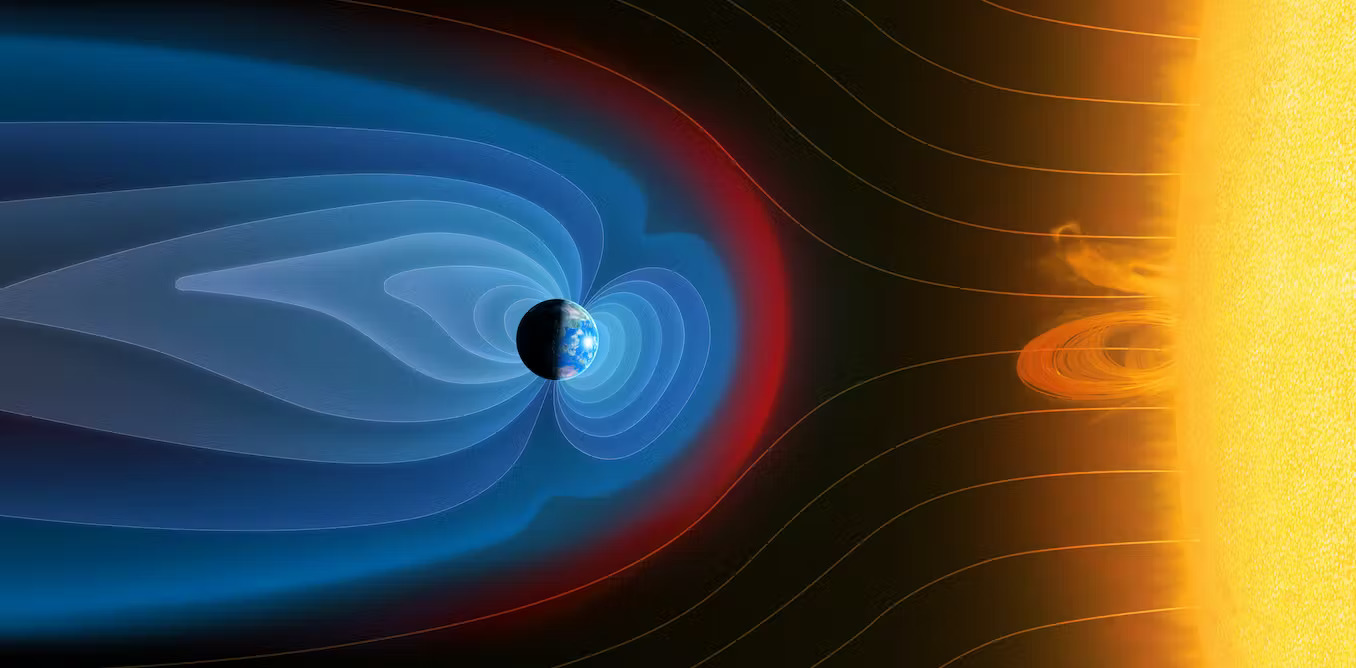
The Earth’s magnetic field deflects particles emitted by the Sun. Mark Garlick/Science Photo Library via Getty Images
The Earth’s magnetic field plays a big role in protecting people from hazardous radiation and geomagnetic activity that could affect satellite communication and the operation of power grids. And it moves.
Scientists have studied and tracked the motion of the magnetic poles for centuries. The historical movement of these poles indicates a change in the global geometry of the Earth’s magnetic field. It may even indicate the beginning of a field reversal – a “flip” between the north and south magnetic poles.
I’m a physicist who studies the interaction between the planets and space. While the north magnetic pole moving a little bit isn’t a big deal, a reversal could have a big impact on Earth’s climate and our modern technology. But these reversals don’t happen instantaneously. Instead, they occur over thousands of years.
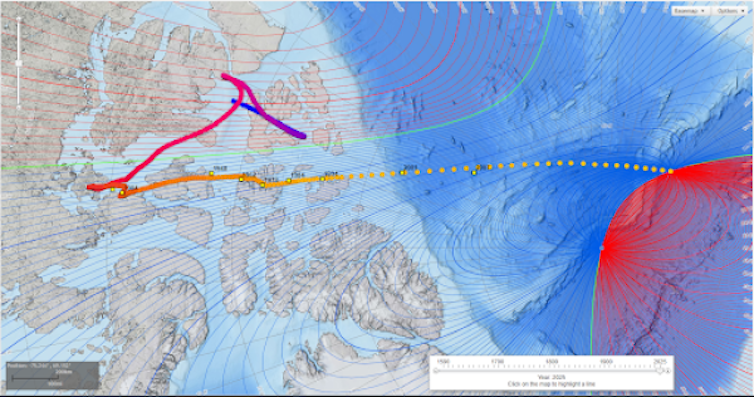
Magnetic field generation
So how are magnetic fields like the one around Earth generated?
Magnetic fields are generated by moving electric charges. A material that enables charges to easily move in it is called a conductor. Metal is one example of a conductor – people use it to transfer electric currents from one place to the other. The electric current itself is simply negative charges called electrons moving through the metal. This current generates a magnetic field.
Layers of conducting material can be found in the Earth’s liquid iron core. Currents of charges move throughout the core, and the liquid iron is also moving and circulating in the core. These movements generate the magnetic field.
–
Earth isn’t the only planet with a magnetic field – gas giant planets like Jupiter have a conducting metallic hydrogen layer that generates their magnetic fields.
The movement of these conducting layers inside planets results in two types of fields. Larger motions, such as large-scale rotations with the planet, lead to a symmetric magnetic field with a north and a south pole – similar to a toy magnet.
These conducting layers may have some local irregular motions due to local turbulence or smaller flows that do not follow the large-scale pattern. These irregularities will manifest in some small anomalies in the planet’s magnetic field or places where the field deviates from being a perfect dipole field.
These small-scale deviations in the magnetic field can actually lead to changes in the large-scale field over time and potentially even a complete reversal of the polarity of the dipole field, where the north becomes south and vice versa. The designations of “north” and “south” on the magnetic field refer to their opposite polarities – they’re not related to geographic north and south.
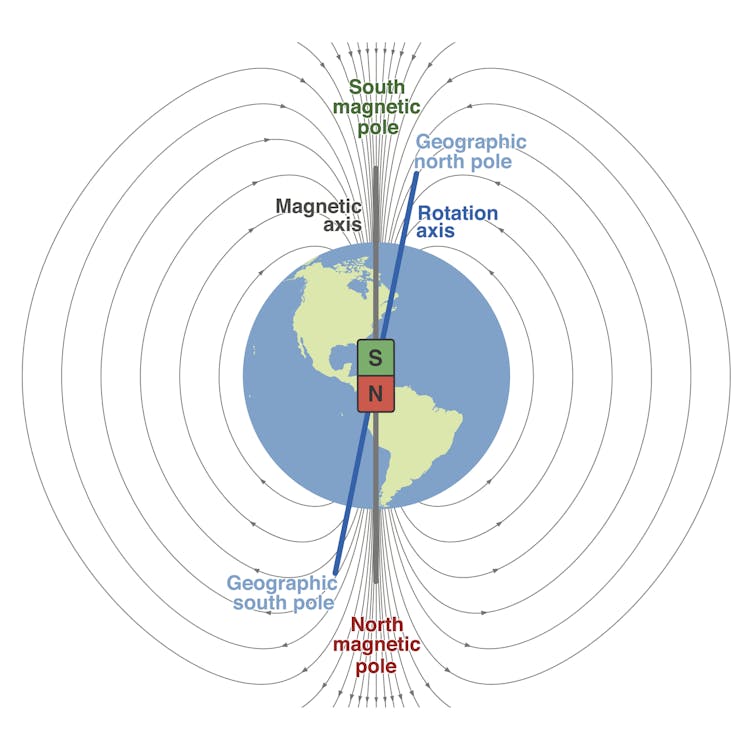
The Earth’s magnetosphere, a protective bubble
The Earth’s magnetic field creates a magnetic “bubble” called the magnetosphere above the uppermost part of the atmosphere, the ionosphere layer.
The magnetosphere plays a major role in protecting people. It shields and deflects damaging, high-energy, cosmic-ray radiation, which is created in star explosions and moves constantly through the universe. The magnetosphere also interacts with solar wind, which is a flow of magnetized gas sent out from the Sun.
The magnetosphere and ionosphere’s interaction with magnetized solar wind creates what scientists call space weather. Usually, the solar wind is mild and there’s little to no space weather.
However, there are times when the Sun sheds large magnetized clouds of gas called coronal mass ejections into space. If these coronal mass ejections make it to Earth, their interaction with the magnetosphere can generate geomagnetic storms. Geomagnetic storms can create auroras, which happen when a stream of energized particles hits the atmosphere and lights up.
During space weather events, there’s more hazardous radiation near the Earth. This radiation can potentially harm satellites and astronauts. Space weather can also damage large conducting systems, such as major pipelines and power grids, by overloading currents in these systems.
–
Space weather events can also disrupt satellite communication and GPS operation, which many people rely on.
Field flips
Scientists map and track the overall shape and orientation of the Earth’s magnetic field using local measurements of the field’s orientation and magnitude and, more recently, models.
The location of the north magnetic pole has moved by about 600 miles (965 kilometers) since the first measurement was taken in 1831. The migration speed has increased from 10 miles per year to 34 miles per year (16 km to 54 km) in more recent years. This acceleration could indicate the beginning of a field reversal, but scientists really can’t tell with less than 200 years of data.
The Earth’s magnetic field reverses on time scales that vary between 100,000 to 1,000,000 years. Scientists can tell how often the magnetic field reverses by looking at volcanic rocks in the ocean.
These rocks capture the orientation and strength of the Earth’s magnetic field when they are created, so dating these rocks provides a good picture of how the Earth’s field has evolved over time.
Field reversals happen fast from a geologic standpoint, though slow from a human perspective. A reversal usually takes a few thousand years, but during this time the magnetosphere’s orientation may shift and expose more of the Earth to cosmic radiation. These events may change the concentration of ozone in the atmosphere.
Scientists can’t tell with confidence when the next field reversal will happen, but we can keep mapping and tracking the movement of Earth’s magnetic north.
–
–
Partners

University of Massachusetts provides funding as a member of The Conversation US.
Republish our articles for free, online or in print, under a Creative Commons license.
–
Want to write?
Write an article and join a growing community of more than 174,300 academics and researchers from 4,798 institutions.









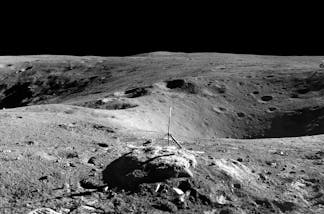


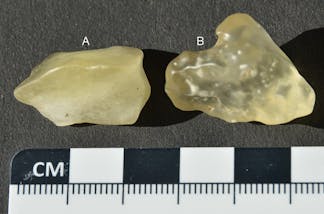
Angela Parker
I have noticed a number of observations recently that may indicate changes to the magnetic field. The first is the south Atlantic anomaly reported a few years ago. Most recently, there was concern of the continuing decrease of the ozone layer, more visible aurora’s at both poles at latitudes not seen before, and most concerning that the excessive removal of groundwater for irrigation has started to destabilize the earth’s plates to the point of leaking vast underground water sources in to the core. No doubt too the removal of forest systems has also changed the weight distribution across the planet. Taken together, I think it’s a grim warning that the activities of humans have globally catastrophic consequences more than what climate change is already delivering. I’m not sure what more humans need to see before they stop doing everything that keeps taking this planet towards unliveable destruction.
Ewan Blanch
Human activities are having serious consequences on the planet, but let’s stick to science rather than nonsense. Where is your evidence, any evidence, that the Earth’s tectonic plates are now destabilized and “leaking vast underground water sources in to the core”? Is that straight out of a B-grade disaster movie script?
Similarly, your claim that “No doubt too the removal of forest systems has also changed the weight distribution across the planet” is highly doubtful, particularly with respect to the magnetic poles. What association does weight distribution on the surface of the planet have to it’s geomagnetic field, which is generated a long, long way away in the core? As for how much of a change in weight distribution has happened? The Earth’s mass is around 6 x 1024 kg, the mass of all plants on Earth (all of them) is estimated to be around 4.5 x 1014 kg, so all plants together account for around 10-8 of a percent of the planet’s mass. By what remotely imaginable mechanism can the weight distribution of such a tiny mass component change the planet’s magnetic field? As a scientist, I can’t think of any.
There are many problems due to human activity to deal with, but fantastical irrational claims aren’t going to help fix them.
Read more